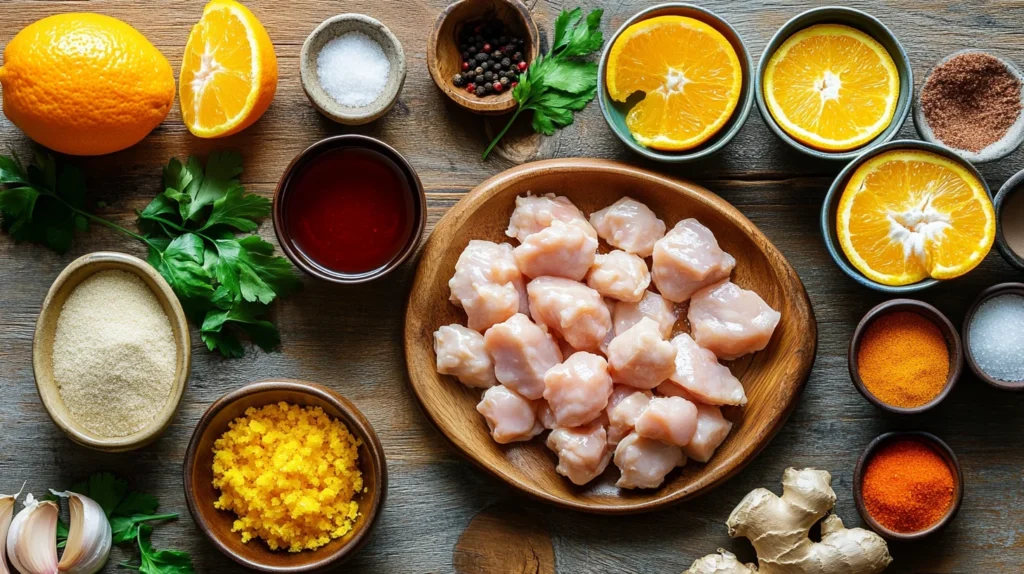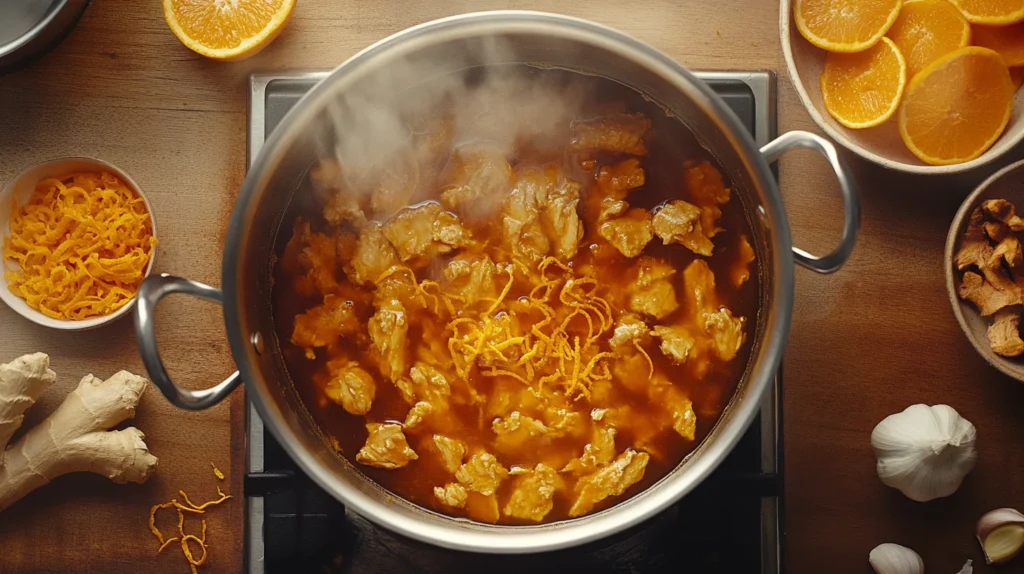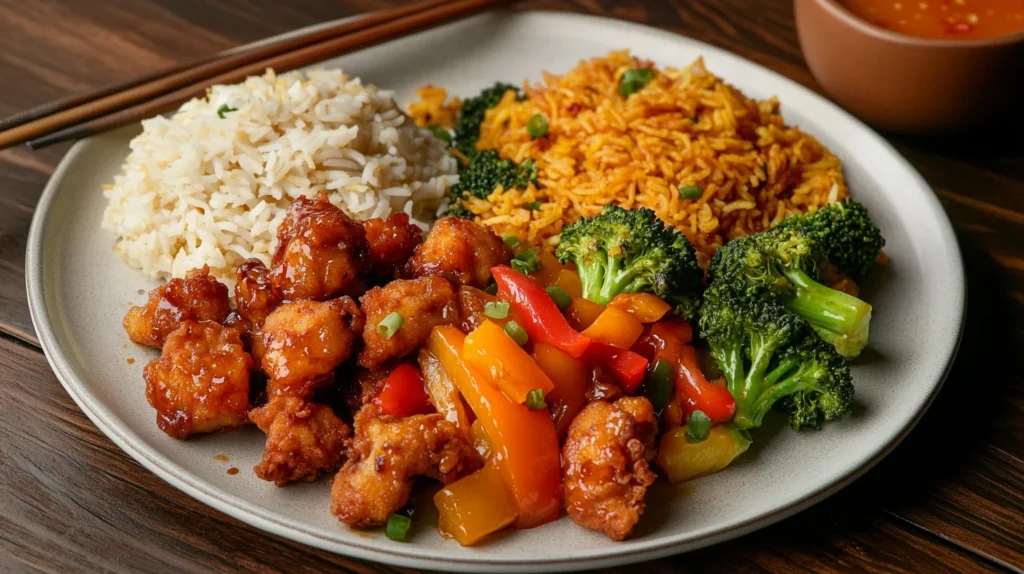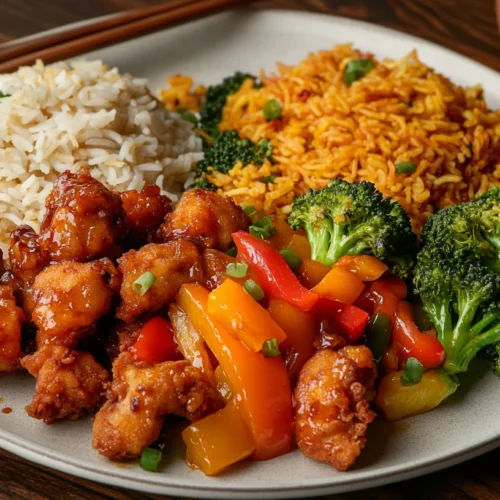There’s something utterly irresistible about the bold, tangy, and sweet flavors of Chinese Orange Chicken Recipe. Whether you’ve tasted it at a bustling food court, a favorite takeout spot, or your local Chinese-American restaurant, this dish is a crowd-pleaser. It’s golden, crispy chicken bites coated in a glossy orange sauce that dances between sweet, sour, and savory.
But what if you could bring that same restaurant-quality flavor right into your own kitchen—without a culinary degree or hard-to-find ingredients? That’s exactly what this guide offers.
In this article, we’re going deep into the world of Chinese Orange Chicken Recipe, covering everything from its origins to foolproof cooking techniques and variations for every diet. Whether you’re a beginner in the kitchen or an experienced home cook, this recipe is designed to be easy, customizable, and packed with flavor. Let’s dig in and learn how to make this takeout favorite a homemade staple!🍊🧡🥡

What is Chinese Orange Chicken Recipe?
A Classic American-Chinese Fusion Dish
Despite what many assume, Chinese Orange Chicken Recipe is not a traditional Chinese dish. Instead, it’s a brilliant product of American-Chinese cuisine, developed to suit local tastes. The dish originated in the United States, reportedly popularized by chefs in Southern California in the 1980s. Most famously, it was made mainstream by chains like Panda Express, which introduced the dish to the masses and turned it into a cultural phenomenon.
It’s an adaptation of classic Chinese sweet and sour dishes, but instead of a vinegar-heavy profile, Chinese Orange Chicken Recipe amps up the citrus, blends in soy sauce, and finishes with a glossy glaze that coats every piece of crispy chicken to perfection.
Despite its name, orange chicken isn’t a traditional Chinese dish. It was developed in the U.S., particularly popularized by chains like Panda Express in the 1980s. It’s closely related to other fusion favorites like Creamy Chicken Florentine that turn comfort food into something extra special.
Why People Love Chinese Orange Chicken Recipe
There’s a reasonChinese Orange Chicken Recipe has become a staple on Chinese-American menus—it hits all the right notes. It’s:
- Sweet from sugar and fresh orange juice
- Tangy thanks to vinegar and citrus zest
- Savory and umami from soy sauce and garlic
- Crunchy and delightful in every bite of golden, fried chicken.
This balance of flavors creates a dish that feels indulgent yet comforting. For many, it’s nostalgic. For others, it’s an exciting introduction to fusion cuisine. The sticky, saucy texture paired with white rice or veggies makes it a go-to favorite for meals at home or on the go.
With this foundation laid, we’re ready to dive into the heart of the recipe—the ingredients that make this dish so special.
Essential Ingredients for Authentic Flavor

Making restaurant-style Chinese Orange Chicken Recipe at home isn’t just possible—it’s surprisingly simple once you understand what each ingredient brings to the table. The flavor and texture that make Chinese Orange Chicken Recipe so iconic come from a careful balance of fresh citrus, umami-rich sauces, and crispy chicken. Below, we’ll break down the key components that create the signature flavor and how you can tweak them to your liking.
Proteins and Substitutes
Chicken: The Star of the Show
Traditionally, boneless, skinless Chinese Orange Chicken Recipe thighs are used for orange chicken. They’re juicy, tender, and stay moist even after frying. However, chicken breast is a popular leaner alternative and works great with proper marination.
- Best cut: Chicken thighs (for juiciness)
- Lean option: Chicken breast (for lower fat content)
- Tip: Cut into bite-sized, uniform cubes for even cooking.
Tofu or Cauliflower – Great vegan alternatives, just like in this Mediterranean Chicken Skillet recipe where plant-based swaps shine.
Vegetarian or Vegan Options
Don’t eat meat? No problem! Chinese Orange Chicken Recipe is super versatile.
- Tofu: Use extra-firm tofu, press out the moisture, and coat it the same way as chicken.
- Cauliflower: Roast or fry cauliflower florets for a plant-based twist.
- Tempeh or Seitan: For a protein boost with a meatier texture.
The Perfect Orange Sauce
The soul of the dish lies in its sauce—a combination of sweet, tangy, citrusy, and savory. Here’s what goes into the magic mixture:
Core Ingredients:
- Fresh orange juice – Avoid bottled juice if you want brightness and natural flavor.
- Orange zest – Adds intense aroma and flavor depth.
- Soy sauce – Brings saltiness and umami.
- Rice vinegar – Provides a subtle tang and balances sweetness.
- Garlic and ginger – For that classic Chinese stir-fry fragrance.
- Brown sugar or honey – Adds sweetness and helps thicken the sauce.
- Cornstarch slurry – For that glossy, clingy finish.
Optional Add-ins for Customization
Want to make your Chinese Orange Chicken Recipe stand out even more? Try these additions:
- Green onions – Add a fresh crunch and mild oniony flavor.
- Toasted sesame seeds – For a nutty finish and added texture.
- Bell peppers – Bring color and a light sweetness.
- Cashews or peanuts – Add a satisfying crunch and a boost of protein.
You can customize the recipe to suit your taste or use what’s already in your pantry!
Step-by-Step Instructions For Chinese Orange Chicken Recipe

So, you’ve gathered all the ingredients, and your kitchen smells like freshly zested orange. Now it’s time to get cooking! This step-by-step guide ensures that even first-timers can make crispy, juicy, and flavor-packed Chinese Orange Chicken Recipe without a hitch. We’ll cover every stage: prepping the chicken, cooking the sauce, and combining everything into a mouthwatering final dish.
Preparing the Chinese Orange Chicken Recipe
Cut and Marinate
Start by cutting your Chinese Orange Chicken Recipe (thighs or breast) into bite-sized cubes. Aim for pieces about 1 to 1.5 inches wide—big enough to stay juicy but small enough to fry quickly.
Optional Marinade:
- 1 tablespoon soy sauce
- 1 teaspoon garlic powder
- 1/2 teaspoon ground white pepper
- 1 tablespoon cornstarch
Let the Chinese Orange Chicken Recipe marinate for at least 15–20 minutes. This gives it more flavor and helps tenderize the meat.
Coat the Chinese Orange Chicken Recipe
To get that signature crispy texture, coat each piece in a dry mix:
- 1/2 cup cornstarch
- 1/2 cup all-purpose flour
- Pinch of salt and pepper
Toss the marinated Chinese Orange Chicken Recipe until each piece is coated evenly. The mix of flour and cornstarch gives you that crunchy outer shell once fried.
Making the Chinese Orange Chicken Recipe Sauce
While your Chinese Orange Chicken Recipe marinates or fries, it’s the perfect time to make the sauce.
Sauce Ingredients:
- 1/2 cup freshly squeezed orange juice
- 1 tablespoon orange zest
- 3 tablespoons soy sauce
- 2 tablespoons rice vinegar
- 3 tablespoons brown sugar (or 2 tablespoons honey)
- 1 clove garlic, minced
- 1 teaspoon fresh grated ginger
- 1 teaspoon sesame oil (optional)
- 1 tablespoon of cornstarch dissolved in 2 tablespoons of water to form a slurry
Steps:
- In a small saucepan, combine orange juice, zest, soy sauce, vinegar, sugar, garlic, and ginger.
- Bring to a simmer on medium heat.
- Stir in the cornstarch slurry and simmer for 1–2 minutes until the sauce thickens and becomes glossy.
- Remove from heat and let it rest while you finish preparing the chicken.
Cooking Method
Now that everything’s prepped, it’s time to cook. You have three main options based on your preference and tools.
Deep-Frying (Traditional)
- Heat oil to 350°F (175°C) in a deep pan or wok.
- Cook the chicken in small batches, flipping occasionally, until it’s evenly golden brown—about 4 to 5 minutes per batch.
- Drain on paper towels.
Pan-Frying (Simpler & Less Oil)
- Warm a thin layer of oil in a non-stick frying pan.
- Add chicken in batches, searing each side for 3–4 minutes until crisp and cooked through.
- Remove and drain excess oil.
Air Frying (Healthier Option)
- Preheat your air fryer to 380°F (193°C).
- Lightly spray the coated chicken with oil and arrange it in a single layer in the air fryer basket.
- Cook for 10 to 12 minutes, turning halfway for even crispiness.
Bringing It All Together
Once your Chinese Orange Chicken Recipe is cooked, heat your sauce again until it bubbles gently. Add the orange chicken pieces to the sauce and toss until they’re evenly coated.The sauce should cling to every piece, turning them glossy and aromatic. Garnish with green onions or sesame seeds, if you like.
You’ve just made authentic Chinese Orange Chicken Recipe—right in your kitchen!
Looking for a breakfast recipe to start your day before this savory dish? Check out the fluffy Japanese Egg Sandwich.
Tips for Perfect Chinese Orange Chicken Recipe

Making great Chinese Orange Chicken Recipe isn’t just about following steps—it’s also about understanding techniques that bring out the best flavor, texture, and balance. These pro tips will help you avoid common pitfalls and guarantee a result that’s crispy, flavorful, and irresistibly saucy.
How to Get Crispy Chinese Orange Chicken Recipe Every Time
Choose the Right Coating
To achieve that signature crispy bite, your Chinese Orange Chicken Recipe needs a coating that can withstand the sauce without going soggy.
- A blend of cornstarch and flour: the go-to combo for a light, crispy coating.
- Tip: Use cold water or keep your batter-coated chicken in the fridge before frying to improve crunch.
Oil Temperature Matters
Whether deep-frying or pan-frying, keep your oil at 350°F (175°C). Too low and your chicken will absorb oil and become greasy. If the oil is too hot, the outside will burn before the inside cooks properly.
- Use a thermometer if possible.
- Cook in small batches to maintain a steady oil temperature.
Drain the Chinese Orange Chicken Recipe Properly
Once fried, drain your Chinese Orange Chicken Recipe on a wire rack or paper towels. Avoid piling them in a bowl, as steam can soften that golden crust.
Balancing Sweetness and Tanginess
The perfect Chinese Orange Chicken Recipe sauce is all about balance—it shouldn’t be overly sweet or lip-puckering sour.
Fresh Orange Zest is Gold
Bottled juice might do the job in a pinch, but fresh zest adds that burst of real citrus aroma. A small amount makes a big impact—begin with a teaspoon and adjust to taste.
Preventing Sauce from Clumping or Burning
Thickening sauces with cornstarch can be tricky if not done right. Here’s how to ensure your sauce stays silky and glossy.
Cornstarch Slurry Technique
Be sure to combine cornstarch with cold water before stirring it into any hot liquid.. Pour it in slowly, whisking constantly.
- For a well-balanced thickness, mix 1 tablespoon of cornstarch with 2 tablespoons of water.
- Don’t over-boil after adding the slurry—gentle simmering is key to prevent separation.
Don’t Let the Sugar Burn
When using honey or brown sugar, keep the heat low—sugar burns easily and can make the sauce taste bitter. Keep the heat at medium to low and stir regularly.
Bonus Tip: Double Sauce Batch
Love extra sauce on your rice or veggies? Double the sauce recipe and set half aside before mixing with the Chinese Orange Chicken Recipe. It’s great for meal prep or drizzling over leftovers.
With these pro tips, you’ll be turning heads at the dinner table—and no one will believe it’s homemade!
Nutritional Information For Chinese Orange Chicken Recipe
While Chinese Orange Chicken Recipe is a delicious comfort food, many home cooks are curious about how it fits into a balanced diet. Whether you’re counting calories, watching carbs, or just trying to eat cleaner, it’s helpful to know what’s in your dish and how to tweak it.
Let’s break down the typical nutrition profile and explore simple ways to lighten things up without sacrificing flavor.
Average Nutritional Breakdown (Per Serving)
Here’s a rough estimate for one standard serving of homemade orange chicken (about 1 cup of chicken with sauce, no rice):
- Calories: 380–450 kcal
- Protein: 22–28g
- Carbohydrates: 30–38g
- Sugar: 14–18g
- Fat: 18–22g
- Sodium: 750–900mg
- Fiber: 1–2g
Keep in mind, these values vary depending on frying method (deep-fried vs. air-fried), type of sweetener used, and portion size.
Healthier Ingredient Substitutions
You don’t have to give up orange chicken to eat healthier. Just swap a few ingredients, and you can cut calories, sodium, and fat while still enjoying a great-tasting dish.
Lower-Sodium Soy Sauce
While regular soy sauce adds deep umami flavor, it’s also high in sodium. Choose low-sodium soy sauce or switch to coconut aminos for a gluten-free, lower-salt alternative.
Sugar Alternatives
Swap out white sugar for:
- Honey or maple syrup (natural sugars)
- Monk fruit or stevia (no-calorie options for keto-friendly recipes)
Tip: Start with smaller amounts—these substitutes can be sweeter than regular sugar.
Air Frying Over Deep Frying
Deep-frying adds unnecessary fat. Try using an air fryer to achieve that crispy finish with much less oil. You’ll reduce overall fat and calories by up to 60%.
Gluten-Free or Keto Adaptations
Many people think Chinese dishes are off-limits for gluten-free or keto diets, but that’s not true. With a few smart changes, orange chicken can easily fit your lifestyle.
Gluten-Free Version
- Swap regular soy sauce for Tamari or Coconut Aminos.
- For the coating, use rice flour or a gluten-free all-purpose blend instead of traditional flour.
- Double-check your cornstarch—some brands include additives with gluten.
Keto-Friendly Orange Chicken
- Use almond flour or crushed pork rinds for coating the chicken.
- Sweeten the sauce with erythritol or monk fruit.
- Skip cornstarch and thicken the sauce with a small amount of xanthan gum (a keto-friendly thickener).
Note: Orange juice contains natural sugars, so for strict keto, you can reduce the amount or replace it with a small amount of orange extract and water for the citrus flavor minus the carbs.
By making these adjustments, you can enjoy this classic dish while sticking to your health goals—without compromising taste.
Best Side Dishes to Serve With Orange Chicken

Orange chicken is bold and flavorful, which makes it the perfect star of any plate. But to build a complete meal, you’ll want sides that complement—not compete with—it. These timeless and inventive side options pair perfectly with orange chicken.
Fried Rice or Steamed Jasmine Rice
Rice is a classic pairing for a reason—it’s neutral, fluffy, and soaks up every drop of that sticky, tangy sauce.
Fried Rice
Made with eggs, vegetables, and soy sauce, fried rice adds texture and color. Mix in green peas, chopped carrots, and scallions to boost both flavor and texture.
Steamed Jasmine or Basmati Rice
For a simpler option, stick with steamed white or brown rice.The fragrant aroma of jasmine rice beautifully complements the citrusy flavor of the orange sauce.
Stir-Fried Veggies or Dumplings
Add some greens to lighten up the richness of orange chicken.
Stir-Fried Vegetables
Sauté snow peas, broccoli, bell peppers, and mushrooms with garlic and a splash of sesame oil—they’re quick, colorful, and full of crunch.
Dumplings or Spring Rolls
Want something fun on the side? Steamed or pan-fried dumplings filled with veggies or shrimp make a delicious combo.
Complementary Drinks and Sauces
Pairing orange chicken with the right drink or dip can elevate your entire meal.
- Green Tea – Clean, herbal, and great for digestion.
- Plum Wine – Sweet and fruity, it complements the citrus notes.
- Chili Garlic Sauce or Sriracha – For those who want a spicier bite.
Variations of the Orange Chicken Recipe
One of the best things about this dish? It’s incredibly adaptable. Whether you’re feeling adventurous or trying to meet dietary needs, here are some delicious versions.
Spicy Orange Chicken
Add red chili flakes, Sriracha, or even a diced Thai chili to your sauce for a fiery twist. A drizzle of chili oil brings a spicy kick and rich flavor complexity.
Vegan Orange Chicken
Replace the chicken with:
- Crispy tofu (pressed and pan-fried)
- Cauliflower florets (oven-roasted or air-fried)
The sauce stays the same—just sweet, sticky goodness over a veggie base.
Orange Chicken with Honey or Pineapple
Swap sugar for honey to add a mellow, floral touch of sweetness. Or add pineapple chunks to the sauce to bring tropical vibes and juicy texture.
Frequently Asked Questions
What is orange chicken sauce made of?
Orange chicken sauce is a flavorful blend of sweet, tangy, and savory elements, made with fresh orange juice and zest, soy sauce, rice vinegar, and a sweetener such as brown sugar or honey.Garlic and ginger are usually added for depth, while cornstarch is used to thicken the sauce into a sticky consistency that clings to crispy chicken. Some recipes also include sesame oil, chili flakes, or hoisin sauce for added richness or heat.
How do the Chinese get their chicken so tender?
Chinese cooking often uses a method called velveting to keep chicken incredibly tender. This involves marinating sliced chicken in a mix of egg white, cornstarch, and sometimes rice wine or soy sauce, followed by briefly blanching it in hot oil or water before stir-frying. This process locks in moisture and prevents the chicken from drying out during cooking. The result? Ultra-soft, juicy meat—just like in Chinese restaurants.
What seasoning to use for orange chicken?
For orange chicken, seasoning starts with a basic marinade of soy sauce, garlic powder, and white pepper. The crispy coating usually includes a touch of salt and pepper, while the sauce gets its flavor from ingredients like:
Fresh orange zest
Soy sauce for umami
Rice vinegar for tang
Garlic and ginger for depth
Optional: chili flakes, sesame oil, or Chinese five-spice for extra complexity
These seasonings come together to create the iconic sweet, tangy, and slightly spicy profile of orange chicken.
What is the Chinese equivalent of orange chicken?
Surprisingly, traditional Chinese cuisine doesn’t have a direct counterpart to the American-style orange chicken. However, dishes like “Chen Pi Ji” (陳皮雞)—a stir-fried chicken dish made with dried tangerine peel—is the closest relative in Chinese cuisine. It’s less sweet and more aromatic, focusing on natural citrus bitterness rather than sugar-heavy glazes. American orange chicken was developed to suit local palates, making it more of a Chinese-American fusion dish than a traditional Chinese recipe.
Why is my orange chicken so bitter?
If your orange chicken tastes bitter, it’s likely due to one of the following:
Excessive orange zest can cause bitterness—especially if the white pith is included, as it’s naturally quite bitter. Always zest only the outer colored skin.
Burnt sugar or garlic: Cooking the sauce on too high heat can scorch the sugar or aromatics, resulting in a bitter taste.
Old or bottled juice: Using low-quality or expired orange juice can affect the flavor.
To fix it, balance with a bit more sugar, honey, or a splash of fresh orange juice to brighten the flavor.
What is the difference between Chinese and Szechuan food?
Chinese cuisine is a broad term that covers many regional styles like Cantonese, Hunan, Szechuan, and more. Szechuan (or Sichuan) cuisine, from the Sichuan province in southwestern China, is known for its bold, spicy, and numbing flavors thanks to ingredients like Szechuan peppercorns, chili oil, and garlic.
In contrast, mainstream Chinese-American dishes like orange chicken are typically sweeter, milder, and less spicy. While traditional Chinese dishes may highlight natural ingredients and subtle seasoning, Szechuan food is intensely flavored, often oily, and meant to be spicy and fragrant.
Conclusion
Chinese Orange ChickenRecipe isn’t just a takeout favorite—it’s a dish you can easily master at home. With crispy golden chicken, a perfectly balanced citrus glaze, and endless customization options, it’s no wonder this recipe has become a global comfort food staple.
Whether you’re cooking for yourself, your family, or guests, this dish promises flavor, fun, and a little bit of that restaurant magic—right from your own kitchen.
So go ahead, grab those oranges, fire up your skillet, and bring some sweet-and-savory joy to your next meal!🍊🍯🧡

Chinese Orange Chicken Recipe
Equipment
- Large mixing bowl
- Knife and cutting board
- Measuring spoons and cups
- Frying pan or deep fryer
- Small saucepan
- Whisk
- Slotted spoon or tongs
- Paper towels or wire rack
- Citrus zester (optional)
- Air fryer (optional)
Ingredients
- For the Chicken:
- 1 lb boneless skinless chicken thighs or breasts, diced
- 1 tablespoon soy sauce
- 1 teaspoon garlic powder
- 1/2 teaspoon white pepper
- 1 tablespoon cornstarch for marinade
- 1/2 cup cornstarch for coating
- 1/2 cup all-purpose flour
- Oil for frying vegetable or canola
- For the Orange Sauce:
- 1/2 cup fresh orange juice
- 1 tablespoon orange zest
- 3 tablespoons soy sauce
- 2 tablespoons rice vinegar
- 3 tablespoons brown sugar or honey
- 1 clove garlic minced
- 1 teaspoon fresh grated ginger
- 1 teaspoon sesame oil optional
- 1 tablespoon cornstarch + 2 tablespoons water slurry
Instructions
- Marinate the Chicken:
- In a large bowl, toss diced chicken with soy sauce, garlic powder, white pepper, and 1 tbsp cornstarch. Let it sit for 15–20 minutes.
- Coat the Chicken:
- Mix flour and cornstarch in a bowl. Dredge the marinated chicken pieces in the dry mix until well-coated.
- Fry the Chicken:
- Heat oil to 350°F (175°C). Fry chicken in batches for 4–5 minutes or until golden and crispy. Drain on paper towels or a wire rack.
- Make the Orange Sauce:
- In a saucepan, combine orange juice, zest, soy sauce, vinegar, brown sugar, garlic, ginger, and sesame oil. Simmer gently, then stir in the cornstarch slurry and cook until thickened.
- Toss & Serve:
- Add the crispy chicken to the hot sauce and toss to coat evenly. Garnish with green onions or sesame seeds if desired.

